NGC 5850
| NGC 5850 | |
|---|---|
 | |
| Observation data (J2000 epoch) | |
| Constellation | Virgo |
| Right ascension | 15h 07m 08s |
| Declination | +01° 32′ 39″ |
| Heliocentric radial velocity | 2 545 ± 1 km/s |
| Distance | 40,33 ± 2,83 |
| Apparent magnitude (B) | 11.5 |
| Surface brightness | 23 mag/arcsec2 |
| Other designations | |
| PGC 53979, UGC 9715, IRAS 15045+0144 | |
References: List of NGC objects (5001-6000) | |
NGC 5850 is a barred spiral galaxy in the constellation Virgo, about 115 million light-years from the Milky Way.[1] Its speed relative to the cosmic microwave background is 2,735 ± 13 km/s,[2] which corresponds to a Hubble distance of 40.3 ± 2.8 Mpc (~131 million ly).[3] NGC 5850 was discovered by German-British astronomer William Herschel in 1786.[citation needed]
Characteristics[edit]
The luminosity class of NGC 5850 is II and it has a broad HI1 line.[4] According to the SIMBAD database, NGC 5850 is a LINER galaxy, that is to say a galaxy whose nucleus presents an emission spectrum characterized by broad lines of weakly ionized atoms. To date, seven non-redshift measurements yield a distance of 18,700 ± 4.629 Mpc (~61 million ly), which is far outside the Hubble distance values.[citation needed] Note that it is with the average value of independent measurements, when they exist, that the NASA/IPAC database calculates the diameter of a galaxy and that consequently the diameter of NGC 5850 could be approximately 58, 7 kpc (~191,000 ly) if we used the Hubble distance to calculate it.
Morphology[edit]
NGC 5850 was used by Gérard de Vaucouleurs as a galaxy of morphological type SB(r)b in his galaxy atlas.[citation needed] Eskridge, Frogel and Pogge published a paper in 2002 describing the morphology of 205 closely spaced spiral galaxies. The observations were carried out in the H band of infrared and in the B band (blue). According to Eskridge and his colleagues, NGC 5850 is a spiral galaxy of type SB(r)ab in the B band and type SB(r)0/a in the H band. The isophotes of the outer bulb are almost circular. The nucleus appears elliptical. The bulb is crossed by a very long bar with ansae at its end. The bar is inclined at 60 degrees to the interior bulb. A complete inner ring is formed at the end of the bar and beyond there is a faint spiral structure. The spiral arms appear to form an incomplete outern pseudo-ring.[5]
Supernova[edit]
One supernova has been observed in NGC 5850, SN 1987B. It was discovered on 24 February 1987 lying 71" west and 145" south of the nucleus. The spectral analysis indicates that was a non-conventional type II supernova.[6]
See also[edit]
References[edit]
- ^ "NGC 5850 - Spiral Galaxy in Virgo | TheSkyLive.com". theskylive.com. Retrieved 2024-04-16.
- ^ "NGC 5850 and 5846 in Virgo". www.jthommes.com. Retrieved 2024-04-16.
- ^ "NGC 5850". www.phys.ttu.edu. Retrieved 2024-04-16.
- ^ a b info@noirlab.edu. "NGC 5850". www.noirlab.edu. Retrieved 2024-04-16.
- ^ Eskridge, Paul B.; Frogel, Jay A.; Pogge, Richard W.; Quillen, Alice C.; Berlind, Andreas A.; Davies, Roger L.; DePoy, D. L.; Gilbert, Karoline M.; Houdashelt, Mark L.; Kuchinski, Leslie E.; Ramirez, Solange V.; Sellgren, K.; Stutz, Amelia; Terndrup, Donald M.; Tiede, Glenn P. (November 2002). "Near-Infrared and Optical Morphology of Spiral Galaxies". The Astrophysical Journal Supplement Series. 143 (1): 73–111. doi:10.1086/342340.
- ^ Tsvetkov, D. Y. (1 April 1989). "Observations of Supernovae 1987B and 1987F". Soviet Astronomy Letters. 15: 129.
Further bibliography[edit]
- Aguerri, J. A. L.; Hunter, J. H.; Prieto, M.; Varela, A. M.; Gottesman, S. T.; Muñoz-Tuñón, C. (July 2001). "An hydrodynamical model of the barred galaxy NGC 5850". Astronomy & Astrophysics. 373 (3): 786–795. doi:10.1051/0004-6361:20010557.
External links[edit]
- NGC 5850 at SIMBAD
- NGC 5850 on WikiSky: DSS2, SDSS, GALEX, IRAS, Hydrogen α, X-Ray, Astrophoto, Sky Map, Articles and images
